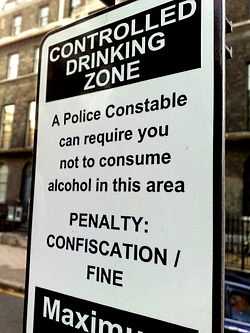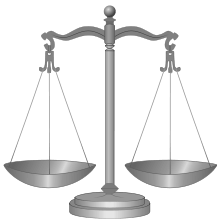Anti-social Behaviour Act 2003
|
| |
| Long title | An Act to make provision in connection with anti-social behaviour. |
|---|---|
| Citation | 2003 c. 38 |
| Introduced by | David Blunkett |
| Territorial extent |
|
| Dates | |
| Royal Assent | 20 November 2003 |
| Commencement | in force |
| Other legislation | |
| Relates to | Local Government Act 1972, Housing Act 1995, Noise Act 1996, Housing Act 1996, Crime and Disorder Act 1998, Powers of Criminal Courts (Sentencing) Act 2000, Police Reform Act 2002, Criminal Justice and Immigration Act 2008 |
Status: Current legislation | |
| Text of statute as originally enacted | |
| Revised text of statute as amended | |
The Anti-social Behaviour Act 2003 (c.38) is an Act of the Parliament of the United Kingdom which almost entirely applies only to England and Wales. The Act, championed by then Home Secretary, David Blunkett, was passed in 2003. As well as strengthening the anti-social behaviour order and Fixed Penalty Notice provisions, and banning spray paint sales to people under the age of 16, it gives local councils the power to order the removal of graffiti from private property.
It also specifically addresses truancy, crack houses,[1] false reports of emergency, fireworks, public drunkenness and gang activity.
Crack house closure orders
Part I of the Act ("Premises where drugs used unlawfully") enables the police to close residential premises concerned in the use, production or supply of Class A drugs and which are associated with serious nuisance or disorder to members of the public in the preceding three months.[2][3] After such a notice has been served, within 48 hours a Magistrates' Court must consider the application, and can make a closure order under Section 2, known as a "Class A drug, supply, distribution or production premises closure Order". The effect of the order is that no-one may enter the premises whilst the order is in place, and it becomes a criminal offence to do so.
Antisocial behaviour closure orders
Part IA of the Act ("Premises associated with persistent disorder or nuisance") was inserted by Section 118 of the Criminal Justice and Immigration Act 2008, and came into force in December 2008. Known as a Part 1A Closure Order or Antisocial Behaviour Closure Order[4][5] the new Sections 11A-11L of the 2003 Act permit the police or local authority to apply to Magistrates to close premises where they are satisfied that within the preceding three months[6] the premises have been associated with "significant and persistent disorder or persistent serious nuisance to members of the public."[7] The order can be made in respect of business or residential premises.[8] Similar to the Part 1 Order (Crack House Closure Order), it becomes an offence to remain in or re-enter the premises for the duration of the order.[9]
Antisocial behaviour injunctions (ASBIs)
Part II ("Housing") amended housing legislation to require social housing organisations to adopt and publish policies on anti-social behaviour. It also strengthens the power of registered social landlords (RSLs) to take action against tenants who cause nuisance or annoyance to neighbours. One power is that secure tenancies can be 'demoted' by order of a County Court, which in theory at least, makes eviction much easier.[10] A further important provision provides a mechanism for RSLs to apply for injunctions against people causing nuisance and annoyance to people in the neighbourhood of their housing stock. Section 13 of the 2003 Act amended Part V of the Housing Act 1996 ('Conduct of Tenants'), by repealing Sections 152 and 153, and inserting new Sections 153A - 153E. Where a person is invited into residential premises by the occupier, in breach of an s.153A injunction, they commit an offence.[11] Although still in force, Section 153A of the Housing Act 1996 has since been substituted by the Police and Justice Act 2006,[12] although this law has not yet come into force.
Parenting orders
Part III ("Parental responsibilities") amends 'parenting orders', which were introduced by the Crime and Disorder Act 1998. These are intended to specify steps parents must take to control their children. It also introduces 'parenting contracts', which are mainly intended to cover child truancy.
Dispersal zones
Part IV ("Dispersal of groups etc.") gives the police powers to disperse groups of two or more persons in any public place if their presence "has resulted, or is likely to result, in any members of the public being intimidated, harassed, alarmed or distressed". There is also a power for a police officer (or PCSO) to accompany any unaccompanied person of under 16 to their home between the hours of 9 pm and 6 am. Section 30 does not apply to lawful pickets,[13] although the human rights implications have been considered by the courts on a number of occasions.[14] The power for police to remove a child under s30 is permissive, not coercive.[15]
Firearms
Part V ("Firearms") amends the Firearms Act 1968 to make possession of an airgun or an imitation weapon in public an offence. The sale of imitation firearms was further limited by section 36 of the Violent Crime Reduction Act 2006 (VCRA) which made sale of realistic imitation firearms (RIF's) an offence. Various groups of people who legitimately use RIF's, for work or pleasure, can provide a seller with a defence against prosecution as provided for in section 37 of the VCRA. These groups are set out in regulations made by the Secretary of State, and can be changed at any time.
The environment
Part VI ("The Environment") contains a selection of miscellaneous provisions. It gives councils power to serve a closure order on premises causing public nuisance by noise.[16] Councils also now have the power to serve a graffiti removal notice on the person in control (usually the owner) of any surface that is street furniture (street furniture is, usually a telephone box, letterbox, bus stop) where graffiti has been applied, this legislation does not apply to private property. There is a right of appeal to the magistrates court over such a notice, and one ground for appeal is that 'the defacement is neither detrimental to the amenity of the area nor offensive'. It makes the sale of aerosol paint to any person under 16 illegal.
Raves and travellers
Part VII ("Public Order and Trespass") amends the Criminal Justice and Public Order Act 1994 in two main ways. First, the definition of a 'rave' is amended so that only 20 people, rather than 100 must be present. Second the powers of police to move unauthorised travellers' sites are strengthened. This Part also amends the provisions of the Public Order Act 1986 concerning public assemblies. The earlier Act gave the police power to intervene if a public assembly of 20 or more people appeared likely to cause 'serious public disorder, serious damage to property or serious disruption to the life of the community'. This Act reduces the number to two.
High hedges
Part VIII ("High Hedges") is in response to concerns about hedges, typically of Leyland Cypress plants, which can grow to 6 metres or more in height, sometimes cutting out light for neighbours. Such hedges are not controlled by town planning legislation (which normally limits the height of fences to 2 metres), and so there was formerly no way of preventing people from allowing such a hedge to grow. This part of the Act gives local authorities the power to investigate complaints made by people affected by such hedges, and, if necessary, to require their reduction. Councils can charge a fee for dealing with such complaints. Soon after implementation, some councils were charging no fee, while the highest in the country was Sevenoaks, which charged £650.[17]
Miscellaneous

Part IX ("Miscellaneous") makes some changes to the mechanisms for serving and enforcing anti-social behaviour orders. Section 89 extended the powers of Police Community Support Officers (PCSOs). The key changes are that PCSOs have the power to stop a cyclist, and Accredited Support Officers or Rail Community Officers can issue FPNs in respect of a number of offences:[18][19]
- Use of insulting or abusive behaviour to cause harassment alarm or distress
- Throwing fireworks in a thoroughfare
- Trespassing on a railway
- Throwing stones etc. at trains or other things on railways
- Buying or attempting to buy alcohol for consumption in a bar in licensed premises by a person under 18
- Knowingly giving a false alarm to the fire brigade
- Wasting police time or giving a false report[20]
- Consumption of alcohol in a designated public place[21]
- Using a public communications system for sending messages known to be false in order to cause annoyance.
Extent
- Part X ("General") limits the extent of the legislation to England and Wales only, apart from Part V.
See also
- Anti-Social Behaviour Order
- Fixing broken windows
- Graffiti abatement
- Neighbours From Hell in Britain
References
- ↑ Anti-Social Behaviour Act 2003 Parts 1 and 1A
- ↑ Anti-Social Behaviour Act 2003, s.2(3)(b)
- ↑ Cumbria Constabulary v Wright (2006) EWHC 3574 (Admin); [2007] 1 WLR 1407
- ↑ Mack, Jon (2008), "Anti-social behaviour: Part 1A closure orders", Journal of Housing Law 11 (4): 71–74
- ↑ Mack, Jon (2008), "Anti-social behaviour closure orders, injunctions, and possession: refining the law", Landlord & Tenant Review 12 (5): 169–171
- ↑ Anti-Social Behaviour Act 2003, s.11(b)(5)
- ↑ Anti-Social Behaviour Act 2003, s.11A(1)(b)
- ↑ Mack, Jon (2009), "Anti-social Behaviour Act 2003: Part 1A closure order", Criminal Law & Justice Weekly 173: 116–117
- ↑ Anti-Social Behaviour Act 2003, s.11D
- ↑ Bates, Justin (2008), "The Disability Discrimination Act 1995 and Possession Orders", Journal of Housing Law 11 (4): 74
- ↑ Lee v Accent Foundation Ltd [2007] EWCA Civ 665; [2008] HLR 3
- ↑ Police and Justice Act 2006, s.26
- ↑ Ashworth, Andrew (2007), "Public Order: Anti-social Behaviour Act 2003 s 30", Criminal Law Review: 243–246
- ↑ Sierny v DPP [2006] EWHC 716 (Admin); (2006) 170 JP 697
- ↑ R (ex parte W) v Commissioner of the Police of the Metropolis [2006] EWCA Civ 458; [2006] 3 All ER 458
- ↑ Parpworth, Neil (2004), "The Anti-social Behaviour Act 2003: the provisions relating to noise", Journal of Planning & Environment Law: 541–559
- ↑ Sevenoaks District Council (2008), High Hedges, retrieved 2008-01-19
- ↑ Police Reform Act 2002 Schedule 5, Para 1(2)(aa)
- ↑ The Local Authorities (Alcohol Consumption In Designated Public Places) Regulations 2007
- ↑ Criminal Law Act 1967, s.5(2)
- ↑ Criminal Justice and Police Act 2001, s.13
Bibliography
- Ashworth, Andrew (2007), "Public Order: Anti-social Behaviour Act 2003 s 30", Criminal Law Review: 243–246
- Flint, John; Nixon, Judy (2006), "Governing neighbours: Anti-social behaviour orders and new forms of regulating conduct in the UK", Urban Studies 43 (5): 939–955, doi:10.1080/00420980600676386
- Greatorex & Falkowski (2006), Anti-Social Behaviour Law, Bristol: Jordans, ISBN 978-1-84661-002-8
- Ormerod, David; Hooper, Rt Hon Lord Justice (2009), Blackstone's Criminal Practice 2010, Oxford: Oxford University Press, ISBN 978-0-19-957424-7
- Sikand, Maya (2006), ASBOs: A Practitioner's Guide to Defending Anti-social Behaviour Orders, London: Legal Action Group, ISBN 978-1-903307-41-0
- Sikand, Maya (2009), Blackstone's Guide to the Criminal Justice and Immigration Act 2008, Oxford: Oxford University Press, ISBN 978-0-19-955382-2
External links
- Hedgeline: "advice and information for Hedge-Victims"
- Neighbours From Hell in Britain
- Home Office's Respect website
| ||||||||||||||||||||||||||||||||||
| |||||||||||||||||||||||||
.svg.png)
